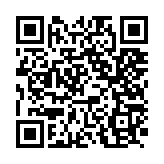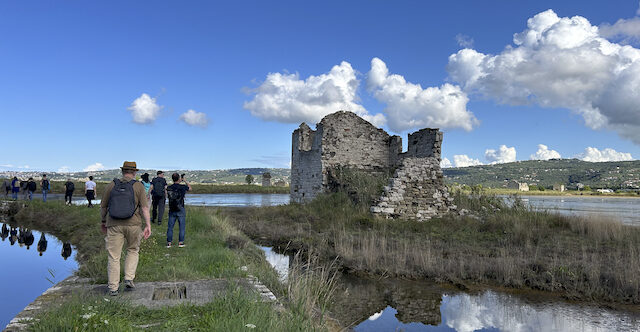Eric Leonardson: Return to the Perimeter – Steklenik
16:00 23 September 2025
Cukrana Gallery, Poljanski nasip 40, 1000 Ljubljana, Slovenia
Catalogue description:
Return to the Perimeter is an augmented reality (AR) soundwalk conceived as a peripatetic lecture. Designed for use with a participant’s own mobile device, the experience employs GPS-triggered audio to spatially align virtual sound elements with the physical environment. The project integrates open-source data, ethnographic interviews and original sound design – drawn from both archival and newly created materials – to explore narratives of social control and relational kinship. Spoken voices, primarily in English, function as narrative agents – alternately guiding or challenging the listener. Although predominantly auditory, the experience incorporates interactive visual elements, including digital maps and motion sensing, creating a multimodal interface responsive to gesture, location and movement.
Author’s Note
Return to the Perimeter represents my first published augmented reality (AR) soundwalk created and released through the Echoes mobile app platform. This project expands my ongoing interests in acoustic ecology, sound design, and performance into a new, mobile-based medium that remains accessible to the public.
The soundwalk is freely available through the Echoes Explorer app, which can be downloaded for iOS and Android devices. Participants may access the work by scanning the QR code or visiting the link provided. Once installed, the app uses GPS to trigger audio zones—what Echoes calls “Echoes”—that align recorded sounds with specific points in the landscape. For the time being, these zones remain active and can be revisited at any time.
The audio materials I composed and curated for this experience include three primary types of sound sources:
- Speech – predominantly from my recorded conversation with composer Annea Lockwood on her inspiration for the 2019 World Listening Day theme, “Listening With…”, commands and cries performed by Plasticene actors, and fragments of anthropologist Ashley Montague’s reflections on American Indian languages.
- Field recordings – drawn from Chicago’s Big Marsh Park (binaural stereo) and Toft Nature Area (mono) in Wisconsin, emphasizing ecological and social dimensions of place.
- Music and sound design – adapted from my work with Plasticene’s The Perimeter (2004) and later expanded for a 2006 radio performance of the same title.
Each sound was intentionally assigned to a geographic zone, guiding participants through overlapping layers of narrative, memory, and environment. Voices act as narrative agents that may instruct or resist, while environmental recordings and sonic textures invite an embodied awareness of place.

‘Return to the Perimeter’ is published and remains accessible at Cukrana Gallery for individual experience using the Echoes mobile app for iOS and Android. Use the QR code or open this link.
Further information about the Echoes platform and its creative environment can be found at echoes.xyz.
Themes from “Walking With Changes” stated in the 2025 Beyond Listening open call for proposals:
- Walking-with changes: rethinking walking as a method of inquiry, approaching listening-with your feet, soundwalking;
- Listening-with and beyond disciplines: employing the convergence of art, science, and technology in sonic ecosystems;
- Staying-with solastalgia: experiencing distress induced by environmental change in our home environment;
- Resonating-with lessons learnt from listening to the Anthropocene, addressing inequality, discrimination, and social justice;
- Being-with other-than-human sonic environments (ecoacoustics and bioacoustics) and engagement with environmental activism;
- Rethinking-with local and regional, historical and contemporary epistemologies and ethics of environmental awareness.
Read the TO)pot Festival / Beyond Listening Symposium 2025 | CENSE program online at https://www.steklenik.si/en/walking-with-changes/programme/.
CENSE Meeting and Organizational Advances
In addition to presenting Return to the Perimeter, I contributed to Friday’s meeting of the Central European Network for Sonic Ecologies (CENSE). Drawing on my experience in organizational membership and nonprofit board service—as a co-founder and past president of the World Forum for Acoustic Ecology (WFAE) and current president of the Midwest Society for Acoustic Ecology (MSAE)—I offered insights on sustainable membership models, governance practices, and the role of nonprofit boards in strengthening cultural networks.
The meeting marked an important step forward in CENSE’s development. Members engaged in a thoughtful discussion about the legal framework (Foundation versus Association, particularly within the Polish context), the mission and identity of the network, and the value of membership as a foundation for collective activity. Central themes included transparency, inclusivity, and the balance between artistic experimentation and organizational sustainability.
Significantly, elections were held to establish a new Board of Directors and Supervisory Board, with defined roles such as Chairperson, Deputy Chair, Secretary, Communications, and members at-large. These structural advances provide a foundation for future events, projects, and partnerships. As one participant remarked, organizational documents should be viewed “as enablers rather than disablers of creativity,” a reminder that governance and artistic vitality can—and must—support one another.
Other topics addressed included:
- Establishing a clear mission statement and defining membership criteria.
- The importance of the word “Network” in CENSE’s name, affirming its role in connecting individuals beyond government institutions.
- Membership fees and the possibility of a sliding scale to ensure inclusivity while sustaining operations.
- Opportunities for special interest groups to self-organize and initiate events within the CENSE framework.
- Long-term visions, such as connecting CENSE’s work to broader cultural milestones, e.g., Gdańsk 2026, actions toward the 2050 climate tipping point, and ecological movements recognizing ecosystems as persons.
These deliberations underscored both the complex challenges and the promise of building a durable, collaborative structure for CENSE. Through formal elections, clarified governance, and commitments to inclusivity, the advances made lay the groundwork for sustained and global cultural and ecological action beyond nation state borders of Central and Eastern Europe.

Acknowledgments
I extend my sincere thanks to the CENSE and TO)POT organizing team, whose dedication and vision made the symposium and festival possible. Their work fostered an atmosphere of friendship, attentiveness, and collective purpose, in which new opportunities for collaboration began to take shape.
Special recognition is due to the Cona Institute, producer of the symposium and founder of Steklenik Gallery, for their sustained commitment to sound art and cultural practice in the public interest. I also thank the co-organizers—the Science and Research Centre Koper and the Institute for Philosophical and Religious Studies—for their important role in shaping the program.
The Symposium in the Field: Walking and Listening in the Sečovlje Salina Nature Park was made possible with the support of Soline, d.o.o. / Sečovlje Salina Nature Park, the Maritime Museum “Sergej Mašera” Piran, and the Muzofil Association. This remarkable setting provided not only a physical landscape for walking and listening, but also a shared ground for cultivating ecological and cultural dialogue.
I am grateful to all participants for their openness and generosity, and I look forward to the future events and partnerships that will grow from the connections made here.
Partial travel assistance for my participation came from the Department of Art and Technology / Sound Practices at the School of the Art Institute of Chicago and the Cynthia and George Mitchell Foundation.
